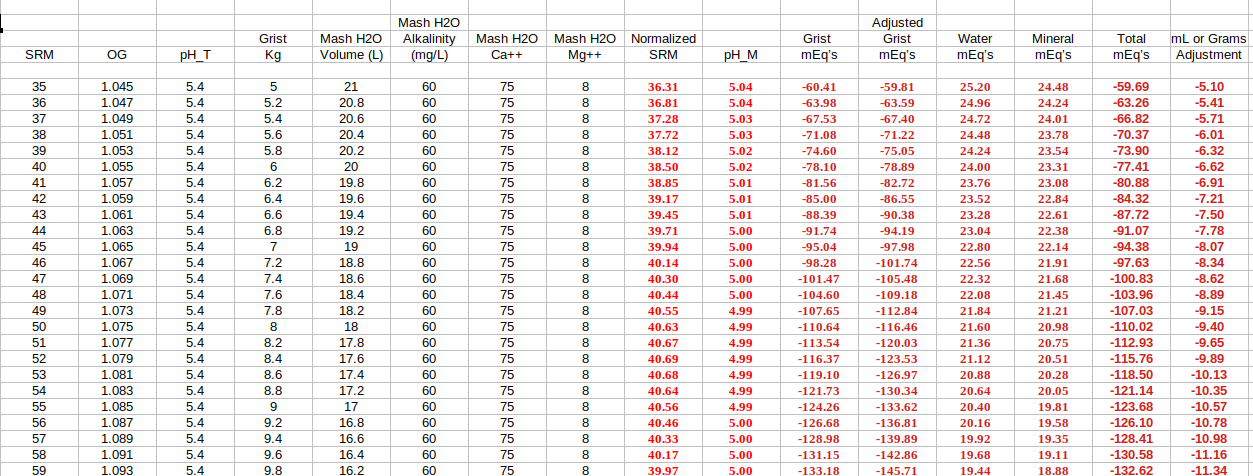Silver_Is_Money
Larry Sayre, Developer of 'Mash Made Easy'
The best calculator is the one that gives the highest percentage of "close to measured" answers across the spectrum of potential grists and mash methodologies and recipe styles. With all of the unknowns that still haunt this science, who knows, but a purely empirical methodology may even win the prize if tweaked sufficiently enough in the right direction(s). But this thread is about the easiest calculator. I say, build it, test it, then tweak it and if/as necessary feather like layer it whereby to enhance it as you strive for perfection as gauged by careful measurement. I'm not claiming any rights to it, but an acknowledgement within the credits would be well appreciated. Only step 4 is likely to, or potentially likely to uniquely bare the signature of my handiwork, but who knows, perhaps someone out there can even lay claim to having gotten there first. The rest is in the public domain. Oh, and don't forget to make it look nice. I've heard (shamefully and embarrassingly enough) on occasion that "you don't sell the stuff, you sell the fluff", or alternately that "you don't sell the steak, you sell the sizzle". I don't like to hear this, as I strive for accuracy, but plenty have emailed me to inform me that they won't use 'MME' because to them it looks ugly or has an abhorrent color scheme, or both. Apparently, one must have their priorities.
But rest assured that there is absolutely zero correlation between the conception that a program outwardly looks like it is spectacularly amazing and the reality as to whether or not it factually is amazing. And no matter how many fall into the classic "fluff and sizzle" trap, rest assured that softwares accuracy in meeting the intended goal is not measured by taking a head count of users, any more than science is measured as to its validity via a head count of scientists whereby to determine and establish a "scientific consensus". New revelations in science are achieved and advanced via going against the grain of consensus. I like to correlate this to the saying of 19th century philosopher Arthur Schopenhauer:
But rest assured that there is absolutely zero correlation between the conception that a program outwardly looks like it is spectacularly amazing and the reality as to whether or not it factually is amazing. And no matter how many fall into the classic "fluff and sizzle" trap, rest assured that softwares accuracy in meeting the intended goal is not measured by taking a head count of users, any more than science is measured as to its validity via a head count of scientists whereby to determine and establish a "scientific consensus". New revelations in science are achieved and advanced via going against the grain of consensus. I like to correlate this to the saying of 19th century philosopher Arthur Schopenhauer:
The trick here being that software can only model and thereby attempt to mimic "future" truth on the basis of probability. It can not ever in and of itself generate certain truth. Therefore no mash pH predicting software can ever output aforehand actual "future" truth and thereby be accepted as self evident. But that has never stopped home brewers from proclaiming certain of such software (generally via the fallacy of head count consensus) to have transcended to the actual achievement of this goal of self evidence, such that it is worshiped at a level whereby it is passed from current believer to potential future believer that it is no longer necessary to own or even consider owning a pH meter. Is this not yet another example of a "circle jerk"?All (new) truth passes through three stages. First, it is ridiculed. Second, it is violently opposed. Third, it is accepted as being self-evident.
Last edited:






































![Craft A Brew - Safale BE-256 Yeast - Fermentis - Belgian Ale Dry Yeast - For Belgian & Strong Ales - Ingredients for Home Brewing - Beer Making Supplies - [3 Pack]](https://m.media-amazon.com/images/I/51bcKEwQmWL._SL500_.jpg)




















